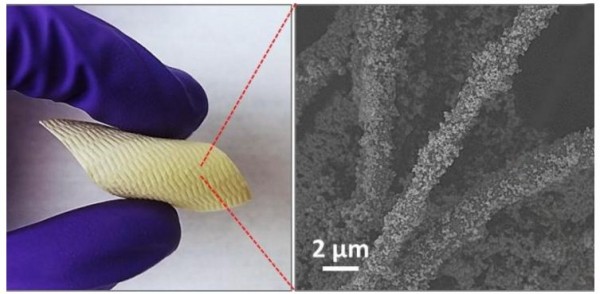New Powder Coating Neutralizes Poisonous Chemicals; Save Lives
| Arthur Dominic Villasanta | | Jun 12, 2017 06:46 AM EDT |
(Photo : American Chemical Society ) A new fabric coating could neutralize chemical weapons and help save countless lives.
Scientists report they've developed a way to adhere a lightweight coating onto fabrics capable of neutralizing toxins used in chemical weapons delivered through the skin.
The life-saving technique could eventually be used to protect soldiers and emergency responders said the study published in the ACS journal Chemistry of Materials.
Like Us on Facebook
Poison was first used on a large scale in World War I, and since then dozens of chemical weapons with lethal potential have been developed.
Scientists have begun exploring the use of zirconium-based "metal-organic framework" (MOF) powders to degrade and destroy the harmful compounds in poison gas.
MOFs are miniscule, porous structures whose large surface areas allow them to absorb vast amounts of gases and other substances. The zirconium within them helps neutralize toxic materials.
But making MOFs can be tedious, requiring high temperatures and long reaction times. In addition, most MOF powders are unstable and incorporating them onto clothing has proven challenging.
Dennis Lee, Gregory N. Parsons and colleagues wanted to see if they could "grow" MOFs onto fabric at room temperature, potentially creating a lightweight shield that could be used on uniforms and protective clothing.
Building on previous work, the researchers exposed polypropylene, a nonwoven fabric commonly used in reusable shopping bags and some clothing, to a mixture consisting of a zirconium-based MOF, a solvent and two binding agents.
To ensure the coating spread evenly across the cloth, they treated the fabrics with thin layers of aluminum, titanium or zinc oxide.
They tested this combination with dimethyl 4-nitrophenyl phosphate (DMNP), a relatively harmless molecule that has similar reactivity as sarin, soman and other nerve agents.
They found that the MOF-treated cloths deactivated the DMNP in less than five minutes, suggesting this process is a viable means to create improved protective clothing.
Tagslightweight coating, fabrics, neutralizing toxin, chemical weapons, poison, Toxins, metal-organic framework, MOF, zirconium-based
©2015 Chinatopix All rights reserved. Do not reproduce without permission
EDITOR'S PICKS
-

Did the Trump administration just announce plans for a trade war with ‘hostile’ China and Russia?
-

US Senate passes Taiwan travel bill slammed by China
-

As Yan Sihong’s family grieves, here are other Chinese students who went missing abroad. Some have never been found
-

Beijing blasts Western critics who ‘smear China’ with the term sharp power
-

China Envoy Seeks to Defuse Tensions With U.S. as a Trade War Brews
-

Singapore's Deputy PM Provides Bitcoin Vote of Confidence Amid China's Blanket Bans
-

China warns investors over risks in overseas virtual currency trading
-

Chinese government most trustworthy: survey
-

Kashima Antlers On Course For Back-To-Back Titles
MOST POPULAR
LATEST NEWS
Zhou Yongkang: China's Former Security Chief Sentenced to Life in Prison

China's former Chief of the Ministry of Public Security, Zhou Yongkang, has been given a life sentence after he was found guilty of abusing his office, bribery and deliberately ... Full Article
TRENDING STORY

China Pork Prices Expected to Stabilize As The Supplies Recover

Elephone P9000 Smartphone is now on Sale on Amazon India

There's a Big Chance Cliffhangers Won't Still Be Resolved When Grey's Anatomy Season 13 Returns

Supreme Court Ruled on Samsung vs Apple Dispute for Patent Infringement

Microsoft Surface Pro 5 Rumors and Release Date: What is the Latest?












